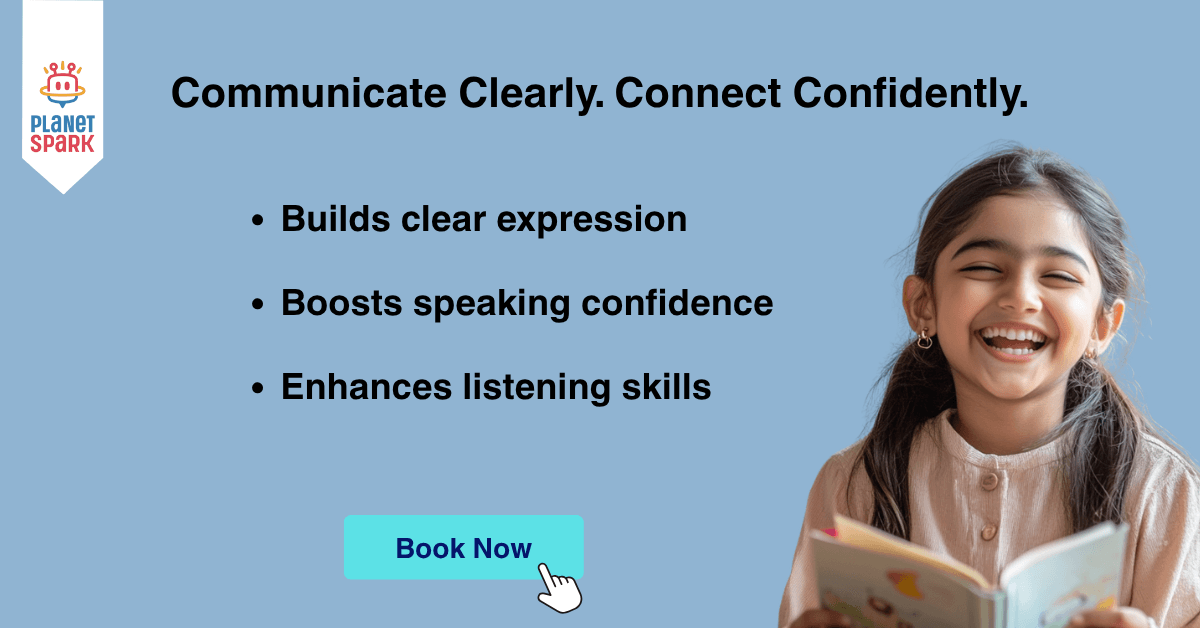Unlock Better Conversations with the 7 Cs of Communication

Table of Contents
- What Are the 7 Cs of Effective Communication
- 1. Clarity
- 2. Conciseness
- 3. Correctness
- 4. Completeness
- 5. Concreteness
- 6. Courtesy
- 7. Coherence
- Why Are the 7 Cs Important
- Applying the 7 Cs in Daily Life
- What Happens When You Don’t Follow the 7 Cs
- Making the 7 Cs Fun for Kids: Activities and Games
- Myths vs Facts About Effective Communication
- Self-Assessment: Are You Communicating Effectively
- How the 7 Cs Elevate Digital Communication
- Integrating the 7 Cs into Curriculum and Careers
- The 7 Cs in Digital Communication
- Communication Is a Two-Way Street
- Conclusion
- FAQs
In a world driven by conversations, messages, and expressions, effective communication is no longer a soft skill- it's a core life skill. Whether you're a student preparing for debates, a professional working in teams, or a child learning to express thoughts clearly, mastering communication can significantly shape your success. But what are the effective communication practices that truly make a difference?
That’s where the 7 Cs of effective communication come in. These seven principles form the foundation of clear, confident, and impactful communication. In this blog, we’ll dive deep into what are the 7Cs of effective communication are, how they help across different areas of life, and how you can practice them effectively.
What Are the 7 Cs of Effective Communication
The 7 Cs of effective communication are guidelines that ensure any message- written, spoken, or visual- is clear, complete, and understood the way it was intended. Let’s explore them one by one.
1. Clarity
Clarity means your message should be easy to understand. Use simple language and avoid jargon or complex terms that might confuse your audience.
Example:
Instead of saying, “We should facilitate academic synergy across verticals,”
Say: “Let’s work together to improve learning.”
When teaching children, clarity is essential. PlanetSpark’s Communication Programs train students to speak clearly, structure thoughts, and use language that connects.
2. Conciseness
Avoid unnecessary details. Say what’s needed in as few words as possible without losing the message’s essence.
Why it matters:
A long-winded explanation can dilute your point or bore the listener.
Example:
Instead of: “At this point, we are currently considering,”
Say: “We’re considering it now.”
Help your child master concise and powerful speaking.
Book a Free Trial with PlanetSpark’s Communication Skills Course Today!
3. Correctness
Correctness involves using accurate grammar, facts, and terminology. A message full of errors can reduce your credibility and confuse the listener.
Example:
Wrong: “Their going too the party.”
Correct: “They’re going to the party.”
Tip: Always proofread, especially when writing.
4. Completeness
The communication should include all relevant information the audience needs to respond or take action.
Example:
Incomplete: “Let’s meet later.”
Complete: “Let’s meet at 5 PM in the library to review the project.”
At PlanetSpark, we teach kids to build complete answers in interviews, class discussions, and storytelling formats- improving clarity and impact.
5. Concreteness
Be specific and to the point. Use facts, numbers, or vivid examples to back your message.
Example:
Vague: “The results were good.”
Concrete: “Sales increased by 20% last month.”
Concrete messages leave no room for interpretation and create stronger impressions.
6. Courtesy
Always be respectful, polite, and positive. Courtesy builds rapport and makes your audience more receptive.
Example:
Instead of: “You didn’t understand,”
Say: “Let me explain it another way.”
7. Coherence
Your message should be logical and well-organized. Sentences should flow naturally and support the main idea.
Example:
Start with your main point, support it with evidence, and conclude with a clear summary or next step.
Want to help your child master all 7 Cs through real-world communication tasks?
Enroll them in PlanetSpark’s Live Communication Classes for Children and Teens.
Why Are the 7 Cs Important
Now that you know what are the 7Cs of effective communication are, let’s look at why they matter:
In School: Helps students give better presentations, participate in debates, and write impactful essays.
At Home: Encourages meaningful conversations with family.
In the Workplace: Ensures messages are understood the first time, reducing errors and delays.
Socially: Builds stronger relationships through better understanding.
So, next time someone asks you, “What are the effective communication skills?”, start with the 7 Cs as your answer.
Applying the 7 Cs in Daily Life
Here’s how learners, parents, and professionals can apply these principles in everyday conversations:
What Happens When You Don’t Follow the 7 Cs
Ignoring the 7 Cs of effective communication can lead to:
Misunderstandings
Poor academic/work performance
Damaged relationships
Loss of credibility
If you’ve ever received a confusing email or sat through a talk that didn’t make sense, some of the 7 Cs were likely missing.
Advanced Communication Scenarios: Using the 7 Cs Like a Pro
As learners grow and start participating in more complex social or academic environments, understanding what are the effective communication principles isn’t enough- they must learn to apply them in nuanced, high-stakes situations.
Let’s explore how the 7 Cs of effective communication apply in various advanced settings:
1. Group Discussions
Whether in a classroom or a job interview, group discussions require clear, courteous, and coherent exchanges.
How the 7 Cs Help:
Clarity & Coherence keep your point focused.
Courtesy helps you disagree respectfully.
Concreteness strengthens your argument with facts.
Example: Instead of “I just feel like it’s wrong,” try “According to a recent UNICEF report, access to education directly improves child health- so I believe free schooling should be a priority.”
2. Public Speaking or Debates
In debates, clarity, correctness, and completeness are critical. You need to back your opinion with data (concreteness), use proper structure (coherence), and keep your tone respectful (courtesy).
Quick Tip:
Practice delivering one point using all 7 Cs- then record and evaluate your performance.
3. Leadership and Team Collaboration
For future professionals, the ability to give instructions, offer feedback, and inspire others depends heavily on the 7 Cs of effective communication.
Use Case:
A project leader must be concise and complete in their directions.
They should provide feedback with courtesy and correctness.
They must ensure their message flows coherently, avoiding confusion.
Making the 7 Cs Fun for Kids: Activities and Games
Children absorb better when learning is engaging. That’s why PlanetSpark uses gamified learning to teach communication.
Here are a few home or classroom activities to make the 7 Cs kid-friendly:
1. Communication Jenga
Label Jenga blocks with the 7 Cs. When a student pulls a block, they must describe a real-life situation where they’ve used that C, or they act it out!
2. 7 Cs Roleplay
Assign different "C" roles in a skit:
One child focuses on being clear,
Another practices courtesy,
Another corrects grammar, and so on.
They deliver a message together, teaching collaborative communication.
3. Message Fixer
Give students poorly written or vague sentences. Let them rewrite them using all 7 Cs.
Example:
Poor: “Stuff happened and we won.”
Improved: “We scored two goals in the last 10 minutes and won the football match.”
These activities are a staple at PlanetSpark- where children practice communication instead of just learning theory.
Myths vs Facts About Effective Communication
Understanding what are the 7Cs of effective communication also means debunking common myths that misguide learners.
| Myth | Fact |
|---|---|
| "Good communicators talk a lot." | Good communicators speak relevantly and concisely. |
| "Using big words makes you smarter." | Clarity and simplicity build stronger connections. |
| "Courtesy makes you sound weak." | Courtesy builds trust and rapport—key in every conversation. |
| "Correctness is only for formal emails." | Correctness matters in every communication—oral or written. |
Help your child grow with real understanding.
Join PlanetSpark’s Communication Courses and Master the Science and Art of Expression.

Self-Assessment: Are You Communicating Effectively
Here’s a quick checklist to help students or professionals evaluate their communication:
Clarity:
Am I using clear and simple language?
Did I explain all technical terms?
Conciseness:
Did I avoid filler words?
Is my message focused?
Correctness:
Are my facts, grammar, and spelling accurate?
Completeness:
Did I include all necessary details?
Have I answered all questions?
Concreteness:
Did I use numbers, names, or examples?
Can my message be misinterpreted?
Courtesy:
Did I show respect and empathy?
Was my tone polite?
Coherence:
Do my sentences connect logically?
Is there a clear beginning, middle, and end?
Not sure how to improve?
Get feedback from expert coaches at PlanetSpark! Personalized mentoring + live tasks = measurable improvement.
How the 7 Cs Elevate Digital Communication
Today, digital platforms- from email to social media to Zoom calls- dominate communication. Here’s how each C applies in the digital world:
Email:
Clarity & Courtesy: Avoid sarcasm, be polite.
Correctness: Double-check tone and grammar.
Completeness: Include subject lines, greetings, and call-to-actions.
Virtual Presentations:
Coherence: Use visuals to support flow.
Concreteness: Back your statements with data.
Conciseness: Keep slides focused, not crowded.
Chat Messages:
Courtesy: Use polite phrases.
Clarity: Avoid emojis when a serious tone is required.
Correctness: Avoid spelling shortcuts unless informal.
Integrating the 7 Cs into Curriculum and Careers
Whether you're a school principal or corporate manager, the 7 Cs can be woven into daily routines:
In Schools:
Rubrics for speaking tasks should include clarity, completeness, and coherence.
Writing assignments can be peer-reviewed using the 7 Cs checklist.
In Corporate Training:
Use the 7 Cs to train client-facing teams.
Evaluate performance emails using a 7 Cs scoring system.
The 7 Cs in Digital Communication
In today’s tech-driven world, communication happens over text messages, emails, video calls, and social media. Here’s how the 7 Cs of effective communication apply digitally:
Clarity is essential for short messages like tweets or SMS.
Correctness ensures that what you post is free from errors.
Courtesy helps avoid misunderstandings in text-based messages that lack tone or facial expressions.
PlanetSpark trains students to navigate online communication responsibly and confidently using the 7 Cs. Try a Free Class Today and See the Difference in One Week!
Communication Is a Two-Way Street
Effective communication isn’t just about delivering your message; it also involves listening, observing, and responding appropriately. That’s why combining the 7 Cs with active listening creates the perfect formula for success in both personal and professional life.
Want to go beyond speaking and build total communication confidence in your child?
Join PlanetSpark’s Communication Masterclass Today!
Conclusion
The 7 Cs of effective communication- Clarity, Conciseness, Correctness, Completeness, Concreteness, Courtesy, and Coherence- act as a golden framework for all forms of communication. Mastering these principles ensures that your messages are well-received, understood, and remembered.
So next time someone asks you, “What are the 7Cs of effective communication?”, you’ll not only know the answer- you’ll know how to apply it.
Remember: words are powerful, but only when used effectively.
FAQs
1. What are the effective communication techniques for students?
Ans. Effective communication techniques include active listening, clear articulation, using the 7 Cs, and practicing empathy and feedback during conversations.
2. What are the 7Cs of effective communication with examples?
Ans. The 7 Cs are Clarity, Conciseness, Correctness, Completeness, Concreteness, Courtesy, and Coherence. For example, being clear and polite when presenting in class ensures better engagement.
3. Why are the 7Cs important in communication?
Ans. The 7 Cs ensure your message is received accurately and respectfully. They improve understanding, reduce confusion, and enhance your overall communication skills.
4. How does PlanetSpark help improve communication in children?
Ans. PlanetSpark offers structured, interactive programs that teach kids the 7 Cs, public speaking, debate, storytelling, and digital communication through live classes and expert mentors.
Personalized Communication Report
Record a video to get a AI generated personalized communication report for your child

Hi There, want to try these
tips for your child with
LIVE with our expert coach?
Let's check your child's
English fluency

